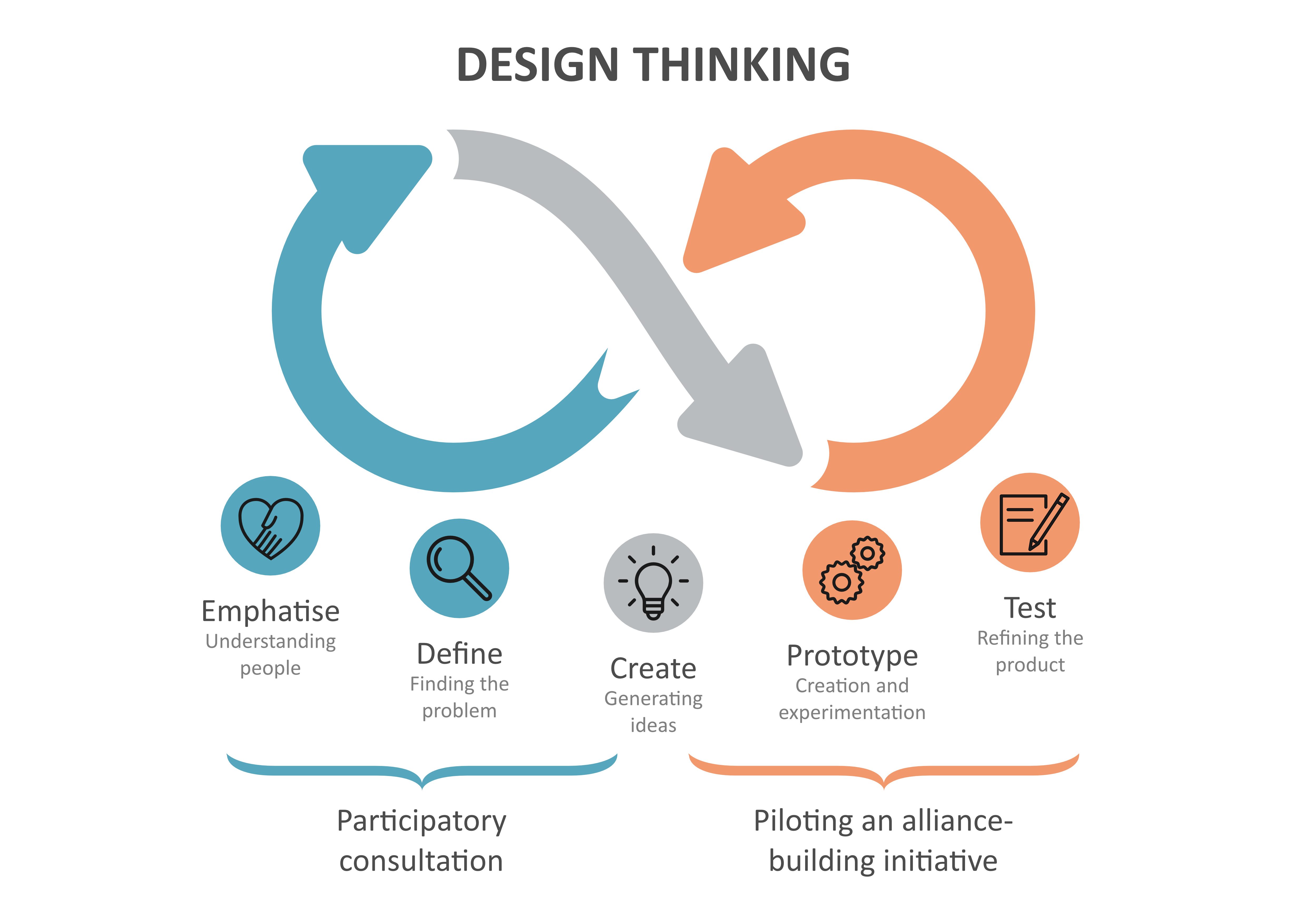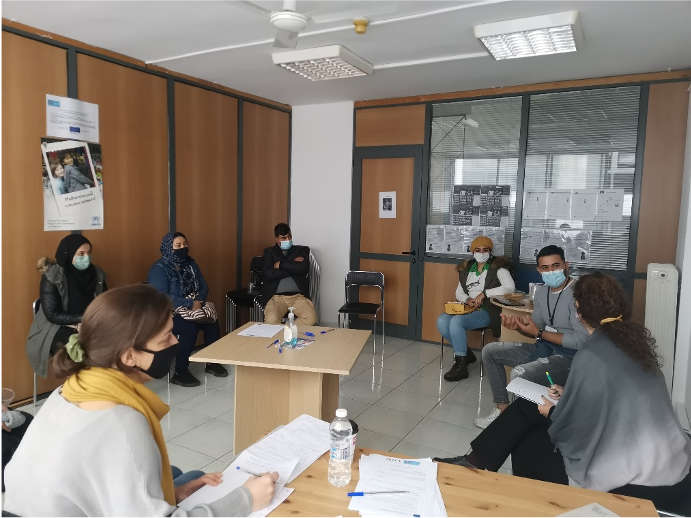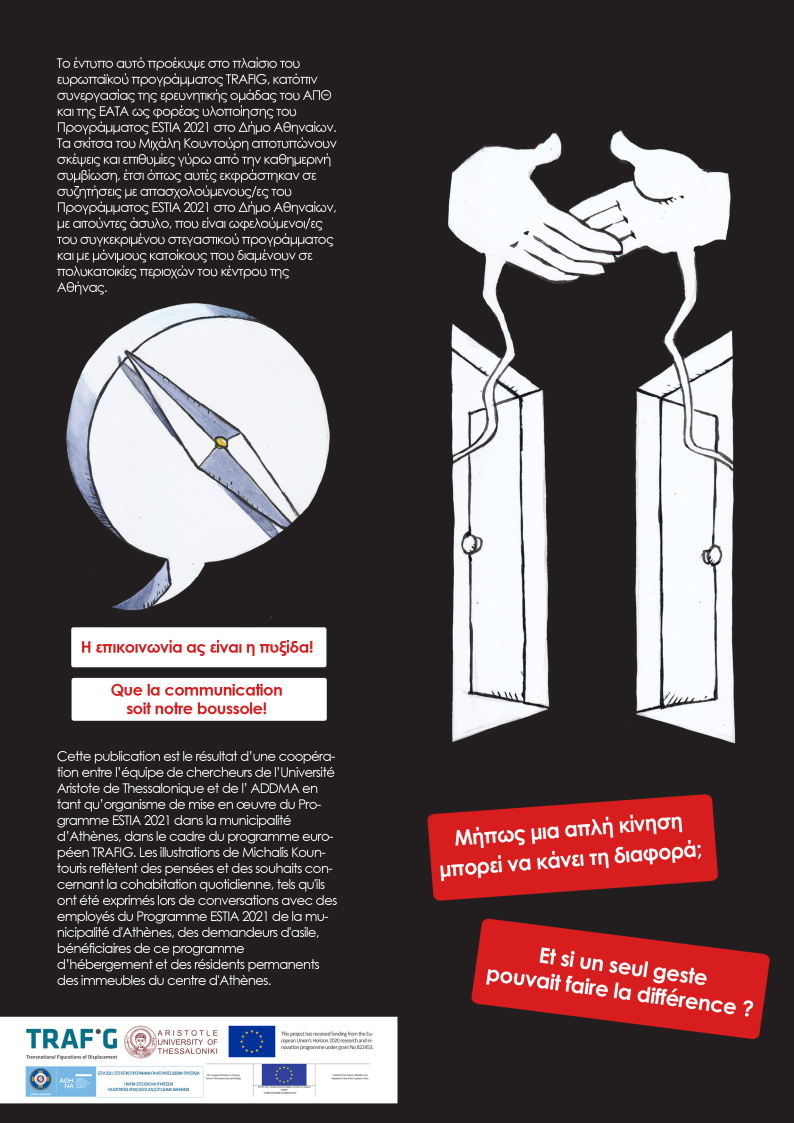Tool #1: Building alliances - The Workshop
Building alliances with design thinking
This tool concerns a participatory consultation method conceived by TRAFIG researchers from the Aristotle University of Thessaloniki (AUTh) in 2021–2022. The tool was developed to improve the cohabitation of asylum seekers with locals in housing blocks in Athens hosting apartments funded by the ESTIA programme, in collaboration with the programme’s implementation partners (ADDMA).
Background information: The ESTIA accommodation programme houses asylum seekers classified as “vulnerable” in apartments across cities in Greece. It was initiated by UNHCR but is managed by the Greek Ministry of Migration & Asylum since 2019. It is implemented by a range of NGOs and municipal agencies. The Athens Development and Destination Management Agency (ADDMA) of the Municipality of Athens is one such organisation implementing ESTIA in Athens.
In Athens, ESTIA apartments are in the same blocks where permanent residents (Greek or other migrants) live. Living closely together raises questions of acceptance, misunderstandings and harmful stereotypes, all of which can escalate into confrontation and conflict. It makes for a difficult life—any missteps or unruly behaviour can get residents kicked out of the ESTIA housing blocks.
Tensions can run high among asylum seekers and with locals who are themselves struggling with daily life. Interactions may be based on misunderstanding, sometimes escalating into confrontations, though most often unfolding in indifference, mistrust and disrespect. Yet, meaningful encounters are also the case (for further information on integroup relations between migrants and locals in Greece see TRAFIG working paper no. 9).
Tackling negative perceptions and encouraging positive interactions is crucial for building alliances between different groups of ‘newcomers’ and ‘established’ residents.
What is the tool?
The purpose of this tool is to ease tensions, smoothen everyday interactions and create opportunities for dialogue among refugees, asylum seekers and locals. Sometimes, a third party is needed to bring these sides together.
Third parties—or parties without a stake in any outcome—are not in the best position to decide what to do. They are in a good position to facilitate what to do, with the decision taken by the people with a stake in the outcome. Co-creating ideas means asking those living together in everyday contexts what they think needs to be done and how. It means using the principles of design thinking and participatory action together.
Our workshop tool had two general stages:
- Participatory consultation (empathise, define, create)
-
Piloting an alliance-building initiative (create, prototype, test)

Participatory consultation
The goal of consultation is to make sure that stakeholders frame, define and co-create ideas with you. To build alliances, we need to hear stakeholders’ perspectives on:
- problems of everyday cohabitation
- ideas to overcome these problems
- examples of positive encounters
- ideas to strengthen positive encounters
Overall, the first stage of this tool requires a great deal of time to organise discussions and/or focus groups with different stakeholders. Plan for at least six months (less for fewer stakeholders, more with multiple stakeholders).

Consultating meetings with ESTIA employees, Farsi- and French-speaking ESTIA beneficiaries, and Greek residents and landlords. Dec. 2021 / Pictures: © Evangelia (Eva) Papatzani, Filyra Vlastou
Piloting an alliance-building initiative
The goal of this stage is to turn the consultation results into a pilot initiative. It consists of three steps:
-
Ideate: Discuss the results of the consultation process amongst yourselves. Cross-tabulate emerging views and ideas. Select one issue that was widely shared amongst all stakeholders. For example, AUTh researchers and the ADDMA cross-tabulated the suggestions of ESTIA employees, beneficiaries, residents/landlords and found that, despite their diverging perspectives, participants longed for cohabitation based on mutual respect and positive, albeit minimal, contact with one another.
-
Design: For ESTIA beneficiaries and permanent residents, communicating to increase knowledge and respect for one another was key—but in a way that didn’t require more interaction. An illustrative leaflet seemed like a good place to start, promoting dialogue and positive communication through the medium of comics. This was produced in collaboration with the cartoonist Mihalis Koundouris.
-
Test: The leaflet was tested in a workshop with key stakeholders (this time mainly managers and employees of other ESTIA implementation partners) to get feedback on its usefulness, design and effectiveness in fostering smoother cohabitation conditions. Feedback was overall positive, revealing a wide interest in using the tool in the field, but also pointing to possible improvements, potential uses or even alternatives to better promote dialogue.

View the full Leaflet - TRAFIG EATA ESTIA
How much does such a tool cost?
Aside from personnel costs, budget items include the venue and basic catering for the discussions and workshop. Another major budget item is the pilot initiative. For the ESTIA housing blocks example, the leaflet included costs of hiring a cartoonist, designing the leaflet, along with layout and printing, for a total of close to 1,500 Euros.
What are some best practices?
The benefit of this tool is to prioritise the stakeholders’ needs above all else.
The participatory approach ensures that stakeholders define their own needs and co-create initiatives that can be tested, redefined and redesigned again and again.
Organising, gathering and listening to people takes time.
All stakeholders need to be heard, but all stakeholders also must want to be heard. If one group refuses to participate, look for proxies—people who can legitimately represent their experience and interests. It won’t be the same, but it may be enough to include them in the process and for future initiatives. Yet, the refusal of participation may also reveal structural problems and insecurities in people’s lives that should be taken into account when designing the outcome of the tool.
Timing of consultations, and place, matter.
Organise consultations when issues surrounding asylum, migration or general xenophobic rhetoric are not ‘hot topics’ i.e., in the news. Use these relatively ‘quiet’ times to build alliances that can be called upon during more tumultuous times. Choose meeting areas that are locally accessible but not considered anyone’s ‘turf’.
Focus group discussions work best with around five to ten people.
Not everyone will be interested in participating, so explain time and again to establish trust and convince people of its usefulness. Look for individuals who are well-connected within their group to collect more participants. Their involvement can have a cascade effect when it comes to experimenting different initiatives.